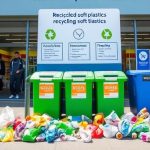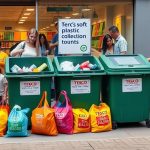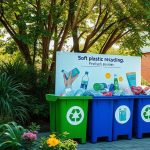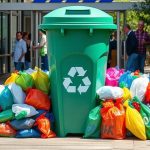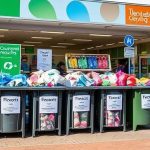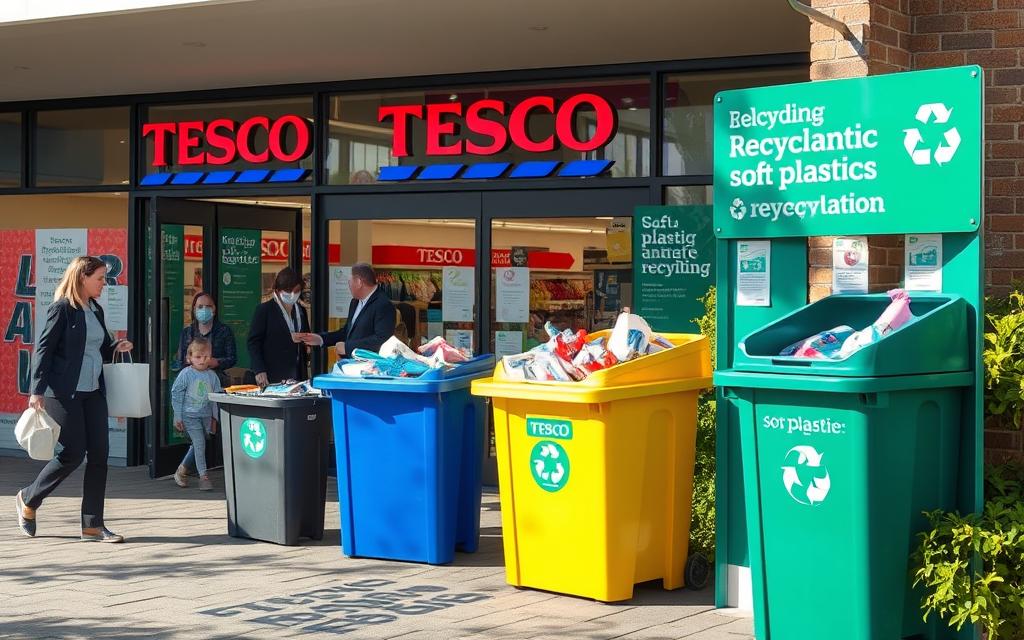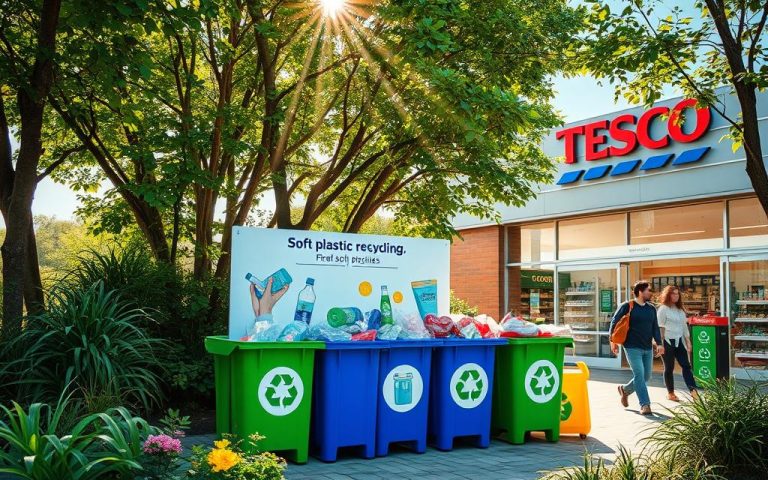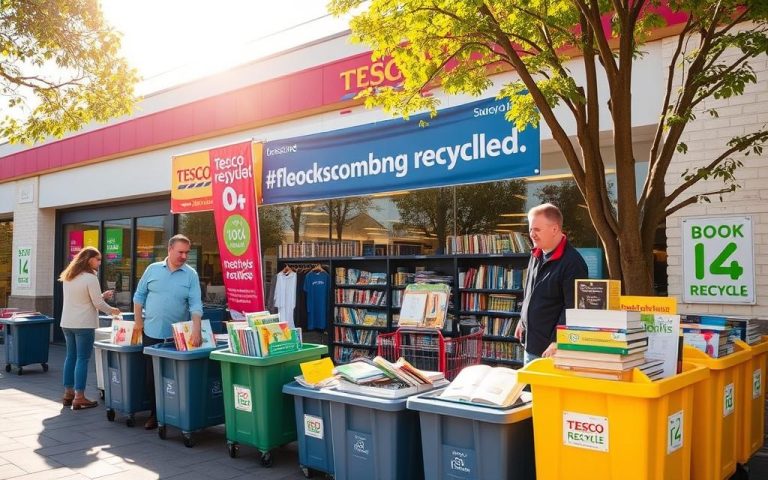A Complete Guide to What You Can Recycle at Tesco
Tesco’s eco-friendly approach has transformed recycling practices. They’ve eliminated nearly 1.5 billion plastic pieces and saved over 6,000 tonnes of packaging material. These efforts showcase Tesco’s strong commitment to environmental responsibility.
The supermarket chain offers various recycling solutions across the UK. Their initiatives make sustainable shopping easier for customers. Tesco provides multiple ways for eco-conscious consumers to reduce their ecological footprint.
Tesco’s user-friendly system helps shoppers make greener choices. They use colour-coded recycling bins and specialised collection points. This guide will explain Tesco’s recycling options to help you shop sustainably.
By using these recycling facilities, customers support Tesco’s environmental mission. Together, we can create a more sustainable future for our planet.
Understanding Tesco’s Commitment to Sustainability
Tesco leads the way in retail sustainability with its innovative approach to waste management. Their commitment to protecting the environment shines through their packaging reduction efforts.
Tesco’s sustainability strategy centres on their comprehensive 4Rs approach. This method transforms traditional waste management practices. It focuses on strategic interventions to minimise environmental impact.
The 4Rs Strategy: A Holistic Approach
Tesco’s 4Rs strategy tackles environmental challenges systematically:
- Remove: Eliminating unnecessary packaging materials
- Reduce: Minimising packaging volume and waste generation
- Reuse: Promoting circular economy principles
- Recycle: Ensuring maximum material recovery
Environmental Targets and Remarkable Achievements
Tesco’s environmental goals have yielded impressive results:
| Achievement | Quantity |
|---|---|
| Plastic Pieces Removed | 1.5 billion |
| Packaging Material Saved | 6,000 tonnes |
| Products with Improved Packaging | 1,600+ |
Innovative Partnerships: TerraCycle and Loop Initiative
Tesco’s partnerships with TerraCycle and Loop are revolutionising recycling solutions. These collaborations challenge traditional waste management thinking. They allow customers to actively take part in sustainable practices.
“Our 4Rs strategy is not just about recycling—it’s about reimagining our relationship with resources.” – Tesco Sustainability Team
Tesco sets new standards in corporate environmental responsibility. Their strategic interventions and collaborative efforts continue to make a significant impact.
What Can Be Recycled at Tesco
Tesco has transformed recycling with innovative approaches to soft plastics and hard-to-recycle materials. The supermarket chain offers comprehensive recycling points across its stores. This makes sustainability more accessible for customers.
Soft Plastics Collection Points
Tesco’s soft plastics recycling initiative has made significant strides in environmental conservation. Nearly 200 stores now offer dedicated drop-off points for soft plastics. Customers can recycle items that are typically difficult to dispose of responsibly.
- Covers 171 locations in South West England and Wales
- Collected over 500 tonnes of soft plastics
- Aims to collect 1,000 tonnes of soft plastics annually
Hard-to-Recycle Materials
The retailer recognises the challenges of recycling certain materials. Tesco recycling points now accept items that local councils often struggle to process, including:
- Crisp packets
- Sweet wrappers
- Plastic film
- Complex packaging materials
In-Store Recycling Facilities
Tesco has transformed in-store recycling, making it easier for customers to participate in sustainable practices. The company has removed one billion pieces of plastic waste. They’ve also reduced packaging by 3,500 tonnes annually.
| Recycling Category | Collection Status |
|---|---|
| Soft Plastics | Collected in 200 stores |
| Packaging Reduction | 3,500 tonnes annually |
| Recycled Content Target | Minimum 30% in new packaging |
“Our goal is to make recycling as convenient as possible for our customers,” says a Tesco sustainability spokesperson.
Only 16% of local authorities collect soft plastics. Tesco’s initiative fills a critical gap in recycling infrastructure. This transforms how consumers approach waste management.
Understanding Recycling Symbols and Labels
Packaging labels can be puzzling. Our guide explains key symbols you’ll see at Tesco. This helps you make smart recycling choices.
Recycling symbols are vital for proper waste management. The UK’s recycling system varies by area. About 75% of councils collect specific packaging types.
Key Recycling Symbols to Know
- Mobius Loop: Indicates recyclability, with a percentage showing recycled content
- Resin Identification Codes (1-7): Help identify plastic types
- Green Dot: Signifies financial contribution to recycling, not recyclability
- Crossed-out Wheelie Bin: Marks electrical items needing special recycling
Different plastic types have varying recyclability:
| Resin Code | Material | Recyclability |
|---|---|---|
| 1 (PET) | Polyethylene Terephthalate | Widely recycled |
| 2 (HDPE) | High-Density Polyethylene | Widely recycled |
| 4 (LDPE) | Low-Density Polyethylene | Collected at specialized points |
| 5 (PP) | Polypropylene | Widely recycled |
Always check local recycling guidelines. Collection abilities differ across regions. Some labels may need special handling or disposal methods.
Understanding packaging labels is your first step towards more sustainable shopping habits.
The On-Pack Recycling Label (OPRL) guides consumers on responsible packaging disposal. Paying attention to these symbols improves recycling efficiency. It also helps reduce waste.
Tesco’s Preferred Materials List
Tesco has created a clever plan for eco-friendly packaging. Their Preferred Materials List helps suppliers and customers choose greener packaging options.
The list sorts packaging materials into three groups. This makes it easier to understand recyclable materials.
Green List Materials: The Gold Standard of Sustainable Packaging
Green list materials are the most sustainable. These nine items are highly likely to be recycled across the UK.
- Easily recyclable packaging materials
- High potential for circular economy integration
- Minimal environmental impact
Amber List Materials: Transitional Packaging Solutions
Amber list materials are currently needed but not ideal. Tesco is working to find better options or improve recycling for these items.
Red List Materials and Banned Items
Tesco aims to remove red list materials completely. These hard-to-recycle packaging types are being phased out to help the environment.
| Material Category | Recyclability | Tesco’s Action |
|---|---|---|
| Green Materials | High (75%+ recyclable) | Actively Encourage |
| Amber Materials | Moderate | Seek Improvement |
| Red Materials | Low/No Recyclability | Eliminate |
Tesco’s approach has already shown great results. In 2021, they improved packaging for over 1,600 products.
They also removed nearly 1.5 billion pieces of plastic from their packaging.
Our goal is to transform packaging materials to support a more circular economy and reduce environmental impact.
Tesco’s dedication to sustainable packaging is driving change. They’re setting a strong example for responsible environmental practices in retail.
Special Recycling Programmes and Initiatives
Tesco leads the way in sustainable packaging with innovative recycling initiatives. They’ve introduced groundbreaking programmes that change how we handle packaging waste. These efforts go well beyond traditional recycling methods.
The TerraCycle partnership is a standout approach to hard-to-recycle materials. It allows customers to recycle items usually thrown away. This creates new opportunities for waste reduction.
Key Recycling Programmes
- Loop reusable packaging system
- Soft plastic collection points
- Specialised TerraCycle recycling schemes
Tesco’s Loop reusable packaging initiative is a big step towards sustainable consumption. It introduces reusable containers for everyday products. This programme encourages customers to rethink single-use packaging.
“Our goal is to create a circular economy where packaging becomes a resource, not a waste product.” – Tesco Sustainability Team
Tesco has set up recycling collection points in larger stores. This makes it easy for customers to join in. Recent statistics show impressive results:
| Initiative | Recycling Achievement |
|---|---|
| Ready Meal Tray Recycling | Up to 75% recycled content |
| Tray 2 Tray Programme | Minimum 30% recycled tray content |
| Packaging Transformation | Eliminated hard-to-recycle materials by 2019 |
Tesco shows strong commitment to sustainable practices through constant innovation. Their partnership with organisations like TerraCycle further demonstrates their environmental responsibility.
Common Mistakes to Avoid When Recycling at Tesco
Recycling errors can ruin entire batches of recyclable materials. Proper techniques are vital for effective waste management and environmental sustainability.
Knowing what’s recyclable is crucial for preventing contamination. Sadly, 40% of people don’t clean their recyclables properly, causing major issues for recycling programmes.
Non-Recyclable Items to Avoid
- Greasy pizza boxes
- Used paper towels
- Plastic bags with food residue
- Broken glassware
- Electronics with mixed materials
Contamination Prevention Strategies
Careful preparation is essential to reduce recycling mistakes. Clean containers thoroughly before recycling them. About 25% of contamination comes from leftover liquids in containers.
“Proper preparation is key to successful recycling” – Tesco Sustainability Team
Proper Preparation of Recyclables
- Rinse containers completely
- Remove labels when possible
- Dry items to prevent mould
- Separate different materials
- Check local recycling guidelines
Mastering these recycling techniques helps Tesco’s sustainability efforts. By avoiding common errors, you’ll ensure more materials are successfully processed and reused.
Conclusion
Tesco’s recycling initiatives show a strong commitment to environmental responsibility. They aim to achieve zero waste to landfill by 2030. In 2022, they recycled over 1 billion plastic bottles, setting new standards for sustainable shopping.
Customers are vital in this environmental journey. They can use in-store recycling facilities and join soft plastic collection programmes. By making conscious packaging choices, individuals can significantly boost recycling efforts.
Tesco’s partnership with TerraCycle transforms soft plastics into community garden furniture. This project showcases how collective efforts can drive meaningful change. The retailer continues to evolve its sustainability strategies.
Tesco offers recycling bins for plastic, paper, and electronic waste. They also work with local councils to create more recycling options. Shoppers can help Tesco reach its sustainability goals by supporting these initiatives.
Every small action matters in environmental stewardship. Your participation in Tesco’s recycling programmes can make a big difference. It proves that responsible shopping is a powerful tool for positive environmental change.
FAQ
What types of soft plastics can I recycle at Tesco?
Tesco accepts various soft plastics at dedicated recycling points. These include carrier bags, bread bags, pasta packaging, and toilet roll wrappings. You can also recycle magazine and newspaper wrappings at most Tesco stores.
How do Tesco’s 4Rs sustainability strategy work?
Tesco’s 4Rs strategy focuses on Remove, Reduce, Reuse, and Recycle. It aims to cut waste by eliminating unnecessary packaging and reducing material usage. The strategy also promotes reusable options and ensures maximum recyclability of remaining materials.
Can I recycle crisp packets and sweet wrappers at Tesco?
Yes, Tesco partners with TerraCycle to recycle hard-to-recycle items. You can drop off crisp packets and sweet wrappers at collection points in participating stores.
What is the Loop initiative?
Loop is a reusable packaging system for buying products in durable containers. Customers return the packaging after use for cleaning and refilling. This system significantly reduces single-use packaging waste.
How do I know if packaging is recyclable?
Look for recycling symbols like the Mobius Loop or Tesco’s specific labels. These show if an item can be recycled in-store or at home. Tesco also provides clear guidance on packaging about recyclability.
What are common recycling mistakes to avoid?
Key mistakes include not cleaning containers and leaving food residue on packaging. Mixing different materials and trying to recycle contaminated items are also common errors. Always check Tesco’s guidelines to ensure proper disposal.
Does Tesco have a goal for packaging sustainability?
Tesco aims to make all Tesco-brand packaging reusable or recyclable by year-end. They use a Preferred Materials List to guide suppliers towards sustainable packaging solutions.
How can I participate in Tesco’s recycling programmes?
Use in-store recycling points and return soft plastics to contribute. Join the Loop programme and sort your waste according to Tesco’s guidelines. Every small action helps reduce environmental impact.


